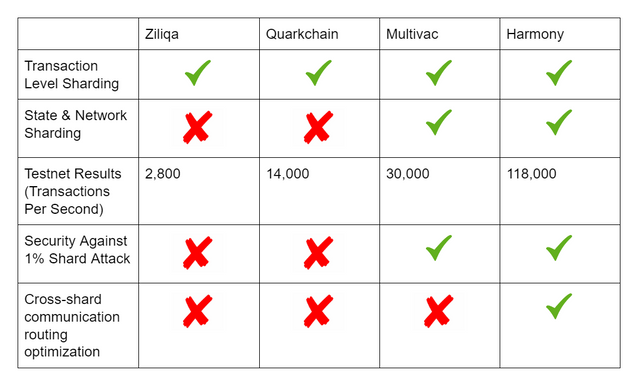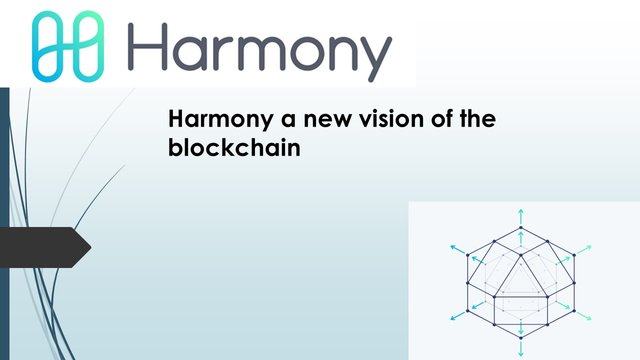Writing Contest: Harmony a new vision of the blockchain

Before talking about Harmony we must first talk a little bit about blockchain, the blockchain system is decentralized, immutable and incorruptible. It is an accounting book where all transactions that are made through a blockchain and are in the public domain are recorded.
The blockchain is an open source, auditable and reliable available to everyone, so it continues to grow exponentially as new projects and applications are born.
Companies that wish to succeed in this ecosystem must be at the forefront of application development, software maintenance and solve the problems that hinder its mass adoption.
These obstacles or limitations for the mass adoption of the blockchain are: the speed of its transactions, the high consumption of energy by mining, high rates, among others, are some of the reasons why the blockchain has not become massive.
Harmony arrived to resolve these limitations with a revolutionary and visionary way to attack these limitations. Harmony is a fully scalable blockchain, energy efficient and most importantly based on optimized fragmentation technology.

Harmony is a decentralized platform of revolutionary consensus of high performance, low latency and low rates designed to boost decentralized economies, thanks to its open infrastructure for world data.
Harmony's goal is to offer scalability and decentralization.
To achieve this, Harmony is a chain of PoS blocks that is capable of scaling linearly, allowing unprecedented transactions per second with ease of scaling as the network is used to a large extent.
Harmony is based on fragmentation technology.

Harmony is similar to the way Google vertically integrates its search infrastructure, adopting a comprehensive stack approach to resolve consensus at scale. End-to-end integration allows you to iterate faster and make more aggressive optimizations than can be done in a modular approach.

A fragmented PoS system is the best compensation between speed and fair consensus. Harmony is at the forefront of this system compared to other platforms.
Here the comparison table with other fragmentation technology projects.


The scalability problems are very real today on many platforms and those who do not face it soon will face it as their projects grow.
One of those projects is Cryptokitties that accumulated a lot of attention and attracted a large number of users that made the speed of Ethereum network transactions slow by not achieving the necessary scalability.
Cryptokitties whose company is Animoca has chosen to partner with Harmony to develop a new collectible crypto ecosystem.

DeFi (Decentralized Finance)
As reported by Binance, DeFi has become one of the most common use cases within the Ethereum network. DeFi consists of loans with cryptocurrencies, which results in high transaction performance requirements. The Ethereum network platform is once again in trouble since it does not have a fast enough scalability to cover the day-to-day demand. This will get worse as the industry continues to grow.
Harmony responds to the growing needs of the DeFi industry efficiently and safely at the same time. With Harmony fragmentation, you can scale linearly as the project grows and ensuring that your infrastructure is not blocked.

Harmony is a fragmentation based blockchain that has revolutionized the industry by giving real response to blockchain problems by allowing decentralized coordination at scale.
Harmony achieves this by applying 10x layer innovations in consensus algorithms, systems and networks to maximize network performance while maintaining decentralization.
The following table shows the achievements of the Harmony protocol:
Fragmentation is the process of dividing computational responsibilities of a database into smaller segments which reduces the total load of the computer, which makes them easier to process.
Harmony has built its system on industrial and academic developments. He has learned from industry and academia in the development of his own scheme of secure fragmentation and linear scaling.
In Harmony there are two types of chains: a beacon chain and multiple fragment chains. The beacon chain is the one that keeps the identity record derived from a random generator. Fragments are those that store separate blockchain states and process transactions. All this is based on a PoS system where the minimum number of votes is the security threshold against malicious actors and these votes accumulate based on the amount of the platform token (Harmony ONE).

Harmony is based on random fragmentation, mutually agrees a random number to determine the fragmentation responsibilities of each node. The agreed number must be: unpredictable, insensitive, verifiable and scalable.
To achieve this, Harmony combines solutions that focus on calculating, testing, sharing and securing information related to the randomness of the numbers generated for node assignments.

In the Harmony platform when talking about the epoch it refers to the time interval in which the fragmentation conditions are set and these conditions change at the end of an era and start a new one, in this way the network is safer.

In Harmony each participation in the vote (Harmony ONE token) allows its respective participant to cast a vote and security is maintained by keeping malicious punters at least 1/3 of the shares with the right to vote in any fragmentation.
Because Harmony has developed an adaptive threshold system, network security is guaranteed.

In the Harmony network once an era ends, the validators who eliminate their participation are expelled from the network. What they decide to stay will receive new voting shares for the next era and will be randomly reassigned to other fragments that have more voting actions than the median of the network, which means that the Harmony chain fragments have to be reset from scratch Every time an era ends.

Harmony differs from others by the protocol beacon chain. It is one of two types of chain, the other is the multiple chains of network transaction processing fragments. Its key functions are:
Generating random numbers that influence which validators the fragments are assigned.
Accept the bets of punters who request to become validators.

On the Harmony platform, each string of fragments maintains its own statement. A user can have multiple balances in different fragments in voting actions and these can be moved at the user's request through cross-fragment transactions.
In smart contracts it is different they can only be kept within the fragment that was created.
Harmony has created a decentralized application developer that can create multiple instances of the same smart contract in different fragments, but although these instances do not share the same status they can communicate with each other through fragments.

The Harmony Pangea network is an experimental area designed for thousands of people to interact and try the Harmony network, where they can have fun while earning rewards. You will have your own currency to play and keep accounting.
In the first 24 hours, the initiative had the following:
• 138 nodes in operation
• 1283 subscriptions
• 77 countries
• 356 keys downloaded
The objectives of Pangea is to test the next milestones and updates of the Harmony core protocol.

Additional Resources:
• Harmony Website
• Harmony OnePager
• Harmony WhitePaper
• Harmony Medium Blog
• Harmony Telegram Group
• Harmony Twitter
• Harmony LinkedIn
• Harmony Instagram
[1] https://blog.ethereum.org/2014/07/05/stake/
[2] https://searchoracle.techtarget.com/definition/sharding

Bounty Submission







Success is your destiny.
Thanks you, i´m glad you liked it. Regards ;)